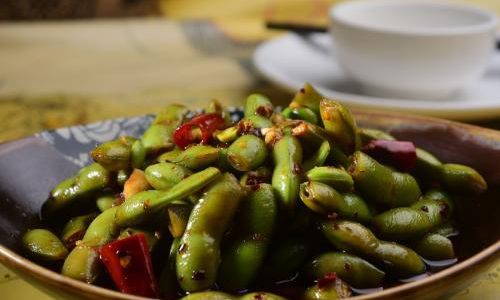Edamame, those vibrant green soybeans often enjoyed as a snack, appetizer, or ingredient in Asian cuisine, have surged in popularity worldwide. Whether steamed, boiled, or sautéed, their buttery texture and mild, grassy flavor make them a versatile addition to meals. However, one common question lingers among home cooks and edamame enthusiasts alike: How long can cooked edamame be stored without compromising its taste, texture, or safety? This article delves into the science of food preservation, the factors influencing edamame’s shelf life, and actionable tips to extend its freshness.
Understanding Edamame: A Brief Overview
Edamame refers to immature soybeans harvested while still plump and green. Unlike mature soybeans, which are dry and hard, edamame pods are tender and edible, though many people prefer to shell them before consuming. Rich in protein, fiber, and antioxidants, edamame is a nutritional powerhouse. However, like all perishable foods, its quality deteriorates over time, especially after cooking. The cooking process softens the beans’ cell walls, making them more vulnerable to bacterial growth and enzymatic reactions that accelerate spoilage.
The Shelf Life of Cooked Edamame: Key Variables
The duration cooked edamame remains safe and palatable depends on several interrelated factors:

- Storage Method: Refrigeration, freezing, and vacuum sealing each offer different levels of preservation.
- Initial Quality: Freshly cooked edamame with minimal handling lasts longer than beans that have been left at room temperature for hours.
- Container Type: Airtight containers or freezer-safe bags reduce exposure to oxygen and moisture, which degrade food.
- Additives: Ingredients like salt, vinegar, or oil used during cooking or storage can act as natural preservatives.
- Temperature Fluctuations: Consistent cold storage is critical; even brief exposure to warm temperatures can invite bacterial growth.
Refrigeration: The Short-Term Solution
Refrigeration is the go-to method for storing cooked edamame for immediate use. When properly cooled and sealed, refrigerated edamame can last 3–5 days. Here’s how to maximize its lifespan:
- Cool Rapidly: After cooking, transfer edamame to a shallow container and spread it in a single layer. This allows heat to escape quickly, preventing condensation that fosters bacteria.
- Use Airtight Containers: Glass or plastic containers with tight-fitting lids minimize air exposure. If using zip-top bags, press out excess air before sealing.
- Avoid Cross-Contamination: Store edamame away from raw meats, seafood, or pungent foods like onions to prevent odor absorption and bacterial cross-contamination.
- Check for Spoilage: Before reheating, inspect for signs of decay, such as a slimy texture, off-putting odor, or discoloration (e.g., grayish or brown patches).
Freezing: The Long-Term Strategy
For those who cook edamame in bulk or want to preserve seasonal harvests, freezing is ideal. Frozen cooked edamame can retain its quality for 8–12 months, though it’s best consumed within 6 months for optimal flavor. Follow these steps for successful freezing:
- Blanch First (Optional): Blanching edamame in boiling water for 2–3 minutes before freezing helps retain color and texture. However, if the beans are already cooked, skip this step.
- Portion Control: Divide edamame into meal-sized portions to avoid repeated thawing and refreezing, which degrades quality.
- Use Freezer-Safe Bags or Containers: Remove as much air as possible to prevent freezer burn. Label bags with the date to track freshness.
- Thaw Safely: Transfer frozen edamame to the refrigerator overnight or use the defrost function on a microwave. Avoid thawing at room temperature, as this promotes bacterial growth.
Vacuum Sealing: A Premium Option
Vacuum sealing removes air from the packaging, significantly slowing oxidation and microbial activity. When combined with refrigeration or freezing, vacuum-sealed cooked edamame can last 1–2 weeks in the fridge and 12–18 months in the freezer. Invest in a vacuum sealer and compatible bags for this method.
Shelf-Stable Alternatives: Canning and Dehydration
While less common for home cooks, canning and dehydration offer non-refrigerated storage solutions:
- Canning: Pressure-canning cooked edamame in jars with acidic solutions (e.g., vinegar-based brines) can extend shelf life to 1–2 years. However, this method requires strict adherence to safety guidelines to prevent botulism.
- Dehydration: Drying edamame at low temperatures (125–135°F/52–57°C) until brittle creates a shelf-stable product lasting 6–12 months when stored in airtight jars. Rehydrate before use by soaking in boiling water.
Recognizing Spoilage: When to Discard Edamame
Even with proper storage, cooked edamame will eventually spoil. Watch for these red flags:

- Texture Changes: Sliminess, mushiness, or excessive dryness indicate degradation.
- Foul Odor: A sour, rancid, or ammonia-like smell signals bacterial activity.
- Mold Growth: Fuzzy spots in green, black, or white hues are unsafe.
- Off Flavors: A bitter, metallic, or overly fermented taste during reheating means discard the beans.
Maximizing Flavor and Texture Post-Storage
Reheating edamame properly is as crucial as storage. Overcooking can turn beans mushy, while uneven heating leaves cold spots where bacteria thrive. Try these methods:
- Stovetop: Sauté edamame in a pan with a splash of water or oil over medium heat until warmed through.
- Microwave: Use a microwave-safe dish with a damp paper towel to retain moisture. Heat in 30-second intervals, stirring between each.
- Oven: For crispy results, roast frozen edamame on a baking sheet at 375°F (190°C) for 10–15 minutes.
The Impact of Cooking Methods on Shelf Life
How you cook edamame initially affects its storage longevity:
- Boiling vs. Steaming: Steamed edamame retains more moisture, which can shorten fridge life if not properly dried. Boiled beans, drained thoroughly, fare better in storage.
- Seasonings: Adding salt, garlic, or chili during cooking acts as a mild preservative. However, acidic ingredients like lemon juice or vinegar may cause texture changes over time.
- Oil-Based Preparations: Edamame tossed in oil (e.g., in stir-fries) has a shorter fridge life due to oil’s tendency to turn rancid.
Environmental and Economic Considerations
Food waste is a global crisis, with perishables like edamame often contributing to landfill overflow. Proper storage not only saves money but also reduces your carbon footprint. Consider these eco-friendly practices:
- Reusable Containers: Opt for glass or silicone containers over disposable plastics.
- Composting: If edamame does spoil, compost it to return nutrients to the soil.
- Batch Cooking: Prepare edamame in quantities aligned with your consumption rate to minimize leftovers.
Frequently Asked Questions
Q: Can I store cooked edamame in its pod?
A: Yes, but shelling before storage saves space and prevents the pods from becoming slimy. If storing pods, ensure they’re dry and airtight.
Q: Does freezing affect edamame’s nutritional value?
A: Freezing preserves most nutrients, though some water-soluble vitamins (e.g., vitamin C) may degrade slightly over time.

Q: Can I refreeze thawed edamame?
A: It’s unsafe to refreeze edamame that has been thawed at room temperature. If thawed in the fridge, refreezing is possible but may compromise texture.
Q: How does store-bought frozen edamame compare to homemade?
A: Commercial frozen edamame is often blanched before freezing, enhancing shelf life. Homemade frozen edamame may have a slightly different texture but is equally nutritious.
Conclusion: Savor Every Bean
Cooked edamame is a delightful, healthful addition to any meal, but its perishable nature demands mindful storage. By leveraging refrigeration, freezing, or vacuum sealing, you can enjoy this versatile legume for days, weeks, or even months after cooking. Always prioritize rapid cooling, airtight packaging, and vigilant spoilage checks to ensure safety and quality. Whether you’re meal-prepping for the week or stocking up during edamame season, these strategies empower you to reduce waste, save money, and savor every bite. So next time you cook a batch of edamame, remember: with the right care, its freshness (and your enjoyment) need never fade.






0 comments